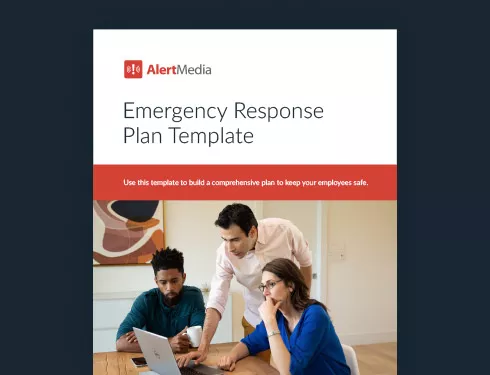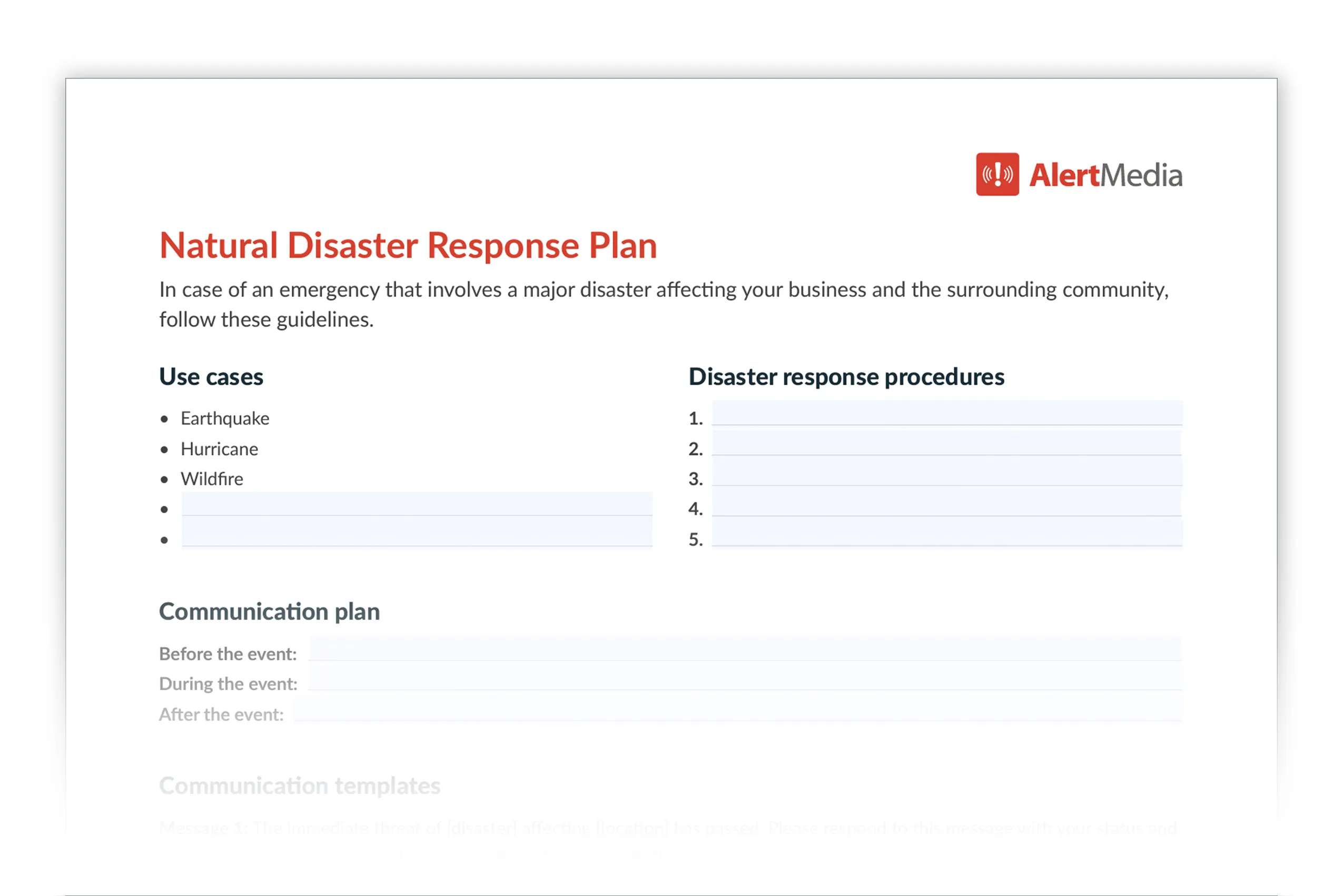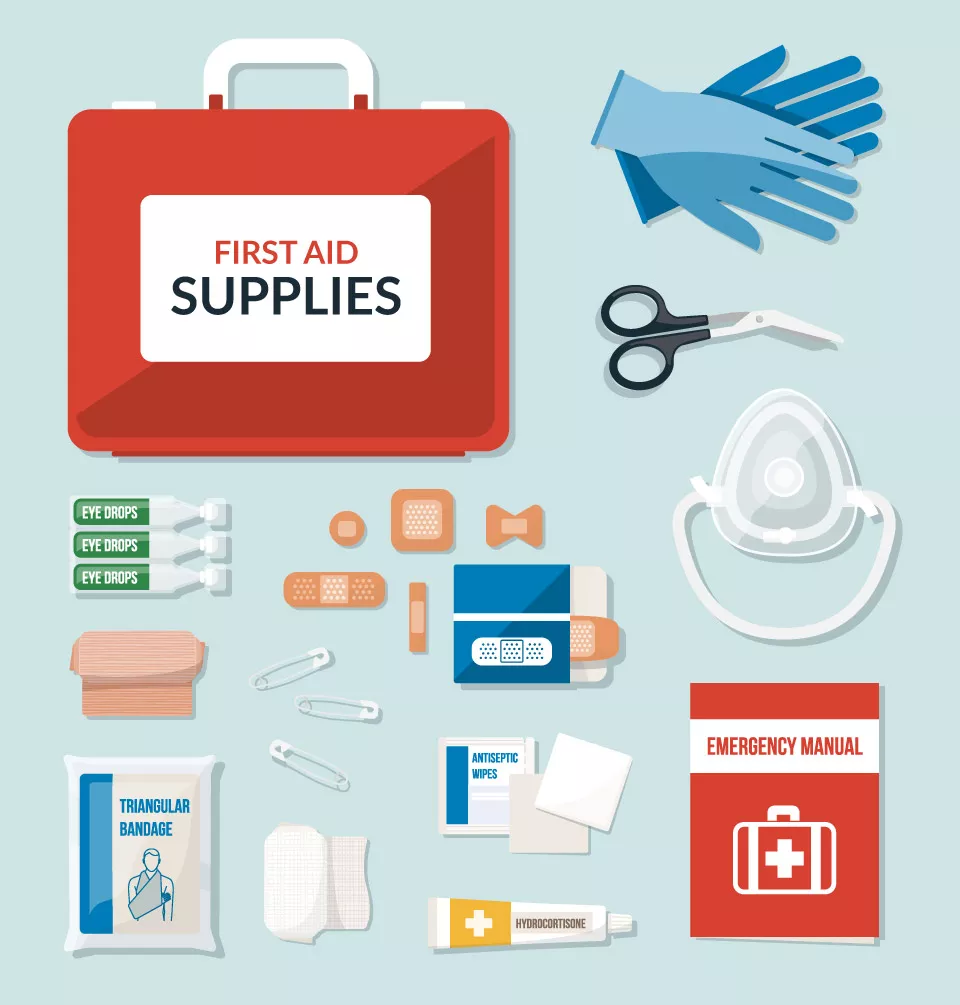
6 Steps to Creating an Effective Emergency Response Plan [+ Template]
Minutes can mean the difference between a minor impact and a major disaster. Develop an emergency response plan now to keep your people, business, and assets safe during any critical event that may arise.

Every emergency management professional will tell you that the best time to prepare for an emergency is well before it occurs. If a hurricane or other severe weather hits, you won’t have time to create an evacuation plan on the spot; you’ll be too busy focusing on immediate hazards. And if your building has a power outage, it’s probably too late to search for generators.
Taking a proactive approach to emergency planning helps you ensure the best possible outcomes for your people and business, allowing you to think holistically about the situation, accounting for many variables. This approach boils down to a holistic emergency response plan for all the threats to your business.
While we can’t necessarily predict when critical events will happen, emergencies are a reality for every business—so you need to be ready. We’ll explore what an emergency response plan is and highlight six steps every organization should take to be prepared for any emergency or business interruption that may arise.
Download Our Emergency Response Plan Template
What Is an Emergency Response Plan?
An emergency response plan is a document that lays out the series of steps your organization will take during a critical event, such as a fire or active shooter threat, to ensure employees’ safety and minimize the impact on emergency operations.
 Preview of the Emergency Response Plan Template
Preview of the Emergency Response Plan TemplateEmergency response plans—just like other emergency management planning documents—are meant to help organizations address various types of emergencies, such as hurricanes, wildfires, winter weather, chemical spills, disease outbreaks, and other hazards. The goal is to reduce or prevent human injury and property damage during critical events. In the planning phase, you will document the detailed steps your organization will take in each emergency scenario.
These emergency action plans also take the guesswork out of roles and responsibilities by specifying which staff members should be part of the response team and which first responders you should contact.
You can create your emergency response plan from scratch or use a pre-built template, like ours, to make the process easier.
Why use an emergency response plan template?
An emergency response plan template can make your planning process quicker and simpler. Every business has a unique range of emergencies they face, but there are some consistent response procedures you can personalize to your risks. Templates also give you a single place to collect necessary contact information for your response team and first responders.
You can download this free template to get started building your plan today.
The best emergency response plans include a list of individuals to contact (and their contact information), evacuation routes, how to act during an emergency, how to mitigate risk to your people and facilities, and detailed communication procedures to follow during and after a specific emergency occurs.
That said, plans can vary widely depending on the setting and circumstances surrounding the crisis. Create a plan that accounts for life-saving actions, such as
- Building evacuations in case of events like fires
- Shelter-in-place orders during severe weather like tornadoes
- Complete lockdown in case of an active shooter situation
Now that you’re up to speed on why your organization needs a plan and what it should cover, let’s examine how to create an effective emergency response plan for your business.
How to Conduct Emergency Response Planning
Each organization is unique, so you may find that additional measures are warranted to protect your business from possible hazards—beyond the examples listed. However, by completing these steps, you will be well on your way to ensuring your team knows what you expect of them and when.
Step #1: Perform a threat assessment

The first step to creating an emergency response plan is to conduct a comprehensive threat assessment to identify the types of events that may affect your organization and analyze their likelihood and potential impact. Specific threats vary by location, sector, and company, and your mitigation strategies and protective actions will vary depending on the scenario. You may need to plan for the following types of events:
- Natural disasters — Hurricanes, tornadoes, earthquakes, wildfires, etc.
- Severe weather — Winter storms, high winds, extreme heat waves, floods, etc.
- Pandemics and infectious diseases — COVID-19, influenza, etc.
- Facility emergencies — Structure fires, hazardous leaks or spills, etc.
- Acts of workplace violence — Active shooters, bomb threats, terrorist attacks, etc.
- Civil disturbances — Protests, demonstrations, riots, strikes, etc.
Even when lives may not be immediately at stake during a crisis, timely communication is just as important. Other events that require a planned response for the success of the business and the safety of your team may include the following:
- IT events — Unplanned outages, planned downtime or maintenance, system testing, cyberattacks or security breaches, help desk escalations, etc.
- Operational events — Logistics coordination, power outages, equipment malfunctions, office closures, travel advisories, safety alerts, shift and overtime scheduling, etc.
- Corporate/crisis communication events — Product recalls, negative publicity, layoffs, major company news, etc.
Using the all-hazards approach to your risk assessment is a great way to ensure you are covering all your bases and able to prepare for any kind of threat.
Step #2: Document contact information
In the event of an emergency that could cause physical harm to your employees, the first call you should make is to your local emergency responders. Aside from 9-1-1, you must have numbers for emergency medical services (EMS), the fire department, healthcare providers/insurance agents, and local law enforcement/police department readily available.
Additionally, ensure you have emergency contact information documented for every employee in case someone goes unaccounted for or gets injured during the emergency.
Step #3: Assign roles and responsibilities
Employees will look to their leaders for reassurance and guidance when an emergency occurs. These leaders should be responsible for activating your emergency response plan, answering questions, and ordering an evacuation if needed. When assigning roles, there are essential considerations to acknowledge. You need to ensure your response team is present, reliable, and can react quickly in an emergency.
Here are the leading roles to consider as part of your emergency response plan:
Emergency response team roles and responsibilities
Incident commander
This employee has overall responsibility for an emergency, including planning and preparation. The incident commander is in charge of emergency response plan activation and is the one all critical decisions should go through.
Communication commander
This person should use the mass alert system to notify employees, call emergency services, and gather reports. If your company uses an emergency communication system, ensure this person is a system admin.
Scene supervisor
This person controls access to the emergency scene and keeps people away from unsafe areas.
Building utilities manager(s)
These team members need to be familiar with the locations and functions of controls for building utility and life safety and protection systems. These systems include ventilation, electrical shutoffs, water and sanitary systems, emergency power supplies, and alarm systems.
Route guide(s)
In the event of an evacuation, these guides play an important role in ensuring that routes are clear and evacuation is orderly and calm. They also help clear evacuation routes and assist those with mobility issues.
Step #4: Take stock of current resources within your organization
Have you inspected those dusty office fire extinguishers, alarm systems, or first aid kits lately? These are critical components of any emergency response plan, so examine them regularly.
Fire extinguishers and alarms
To support your fire safety, the National Fire Protection Association recommends refilling reusable fire extinguishers every 10 years and replacing disposable ones every 12 years. Periodically remind your employees where the fire extinguishers are located in the workplace. Maintain and test any fire alarms on your premises. Run regular fire drills to get your team used to the evacuation process.
Alarm systems
Inspect fire alarm systems annually, at the very least. OSHA recommends testing non-supervised employee alarm systems every two months. This inspection covers a host of details, depending on the type of alarm system, like inspection of the control panel(s), tests of all associated devices such as smoke detectors and heat detectors, warning systems operations, and batteries and power.
First aid kit
OSHA requires that “employers provide medical and first aid supplies commensurate with the hazards of the workplace.” Since many items in a first aid kit have expiration dates—typically three to five years after manufacture—and can become damaged by frequent use, moisture, and exposure to the air, it is vital to regularly check your first aid kit and replace any supplies as needed. As a proactive approach, restock items after use and inspect first aid supplies every three months. Provide the necessary first aid training so your team is prepared to use these supplies and help their coworkers in emergencies, big and small.

Step #5: Determine your response plan steps
Next, decide what steps to follow in an emergency. Customize each event response so the procedures are specific and clear.
For example, here’s how you might plan for an evacuation response.
Emergency fire evacuation plan example
A good fire evacuation plan for your business will include primary and secondary escape routes.
- Clear signs should mark all the exit routes and fire escapes.
- Keep exit routes clear of furniture or other objects that could impede your employees’ direct means of egress.
- Make multiple maps of floor plans and diagrams for large offices and post them so employees know the evacuation routes.
- Develop a separate evacuation plan for individuals with disabilities needing additional assistance.
Once your people are out of the building, where do they go?
- Designate an assembly point for employees to gather.
- Your response team should be at the assembly point, collecting a headcount and providing updates.
- Ensure the escape routes and the assembly area can accommodate the expected number of employees who will be evacuating.
Be sure to consider your disaster recovery efforts or what you do once the crisis is resolved. With planning that extends to recovery, your business can move forward and get back to work as normal. For example, if you have a spill of hazardous materials, your emergency response plan will account for how to keep people safe and contain the spill. The recovery section of your template will explain how to clean up the spill and get that area of the building back to safe working conditions.
Step #6: Decide how to communicate with your employees
One of the most critical parts of any emergency response plan is how you will communicate. When developing your emergency communication plan, consider how to notify employees of a critical event, how the information will be delivered and received, and how effective your communication channels will reach every employee in harm’s way.
During critical events, phone calls and emails are no longer enough. Manual phone trees are prone to misinformation and long delays, and an email alert system alone just doesn’t cut it for emergency communication.
Research suggests that only 65% of employees open internal emails. For workers constantly inundated with messages, internal emails don’t create the sense of urgency needed for time-sensitive information. Hourly and frontline employees—such as retail associates and distribution center workers—often do not have a company email address at all, or they don’t have access to it from their personal phones outside of business hours. And if phone lines are down or email is inaccessible—as can often be the case in emergency situations—your employees may never receive the message. For example, if an organization is hit with an IT virus, relying on email as the only communication channel would be useless and perhaps even counterproductive.
Include notification templates in your emergency response plan to send messages about an incident as quickly as hitting a button. Our template includes examples of what those messages might look like and spaces to compose your own.
Leveraging Technology to Improve an Emergency Preparedness Plan for the Workplace
Today’s workforce is more distributed than ever, especially with a drastic shift to remote and hybrid working environments. This distributed model makes emergency communication increasingly important—but also more challenging.
A modern emergency notification system enables the fast, reliable delivery of mass notifications to any size audience, on any device, over any communication channel. And every organization—regardless of size, industry, or location—will face unexpected events they can manage more effectively with the help of emergency communication software.
When evaluating mass notification solutions, it may be easy to fall into the trap of thinking a standalone text messaging tool is sufficient. But a simple mass texting system doesn’t have the functionality to communicate reliably with your people during critical events. When the health and safety of your people are at stake, only an enterprise-grade emergency communication system can offer the speed, reliability, and user experience you need.
A mass notification system with multichannel delivery, two-way communication, pre-built notification templates, and threat intelligence can help protect your people and business. With a modern emergency communication system, you can rapidly send and receive messages across multiple channels and ensure everyone gets the information they need when they need it. By automatically syncing with your HRIS or Active Directory, you’ll never have to worry about inaccurate employee contact information, which is critical to safeguarding message deliverability.
Designing a Modern Emergency Response Plan
Every business needs a solid plan for communicating with employees during emergencies and other business-critical events. Minutes can mean the difference between a minor impact and a major disaster. The heat of a crisis is not the time to figure out how to effectively communicate and ensure the safety of your employees.
By building out your emergency response plan in advance, your business is prepared to act at the first signs of a crisis. Download this template to make your planning process as simple and effective as possible—so you can get back to leading safe everyday operations.





